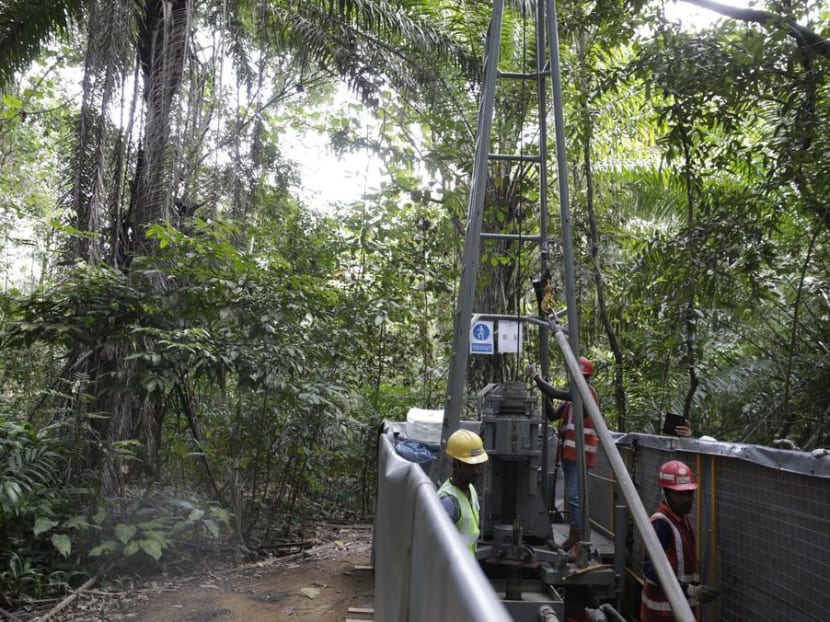Govt will do ‘whatever it can’ to protect Central Catchment Nature Reserve: Lam Pin Min
SINGAPORE — Pledging that the authorities will do everything possible to protect the Central Catchment Nature Reserve, Senior Minister of State for Transport Lam Pin Min said the Government would continue working with nature groups to minimise the impact of the Cross Island Line going underneath the reserve.

Site investigation works being carried out in the Central Catchment Nature Reserve as the authorities assessed the options for the Cross Island Line.
SINGAPORE — Pledging that the authorities will do everything possible to protect the Central Catchment Nature Reserve, Senior Minister of State for Transport Lam Pin Min said the Government would continue working with nature groups to minimise the impact of the Cross Island Line going underneath the reserve.
“We will do whatever we can to protect our Central Catchment Nature Reserve,” Dr Lam told reporters on Wednesday (Dec 4) near the Botanic Gardens MRT Station.
The Government announced on the same day that the Cross Island Line would run under the Central Catchment Nature Reserve, as it is more beneficial to Singaporeans than the other option of skirting the reserve.
With advanced engineering studies on this direct option set to begin next year, Dr Lam said the authorities would work with nature groups to devise more mitigating measures if necessary.
The direct option means that 4km of the route will run beneath the Singapore Island Country Club’s Island Golf Course, Central Catchment Nature Reserve and Pan Island Expressway. Of this, 2km will be under the reserve.
Explaining the Government’s decision after six years of public engagement on the matter, Dr Lam said that the authorities had done “whatever is possible” to limit the risks associated with the line running beneath the reserve.
The Government consulted academics, nature groups and an international panel of advisers, and carried out an environmental impact assessment, he noted.
“We have done whatever is possible… And this is the best decision based on whatever information that has been available,” he said. “We feel that we have done our due diligence, and therefore, we have decided on this direct alignment.”
Released in September, the latest assessment report found that the environmental impact of the two underground alignment options could be “adequately managed” with comprehensive mitigating measures and monitoring plans.
Dr Lam said that because both options were found to be feasible, the Government had to look at other considerations, such as construction costs, travel time, as well as potentially higher fares for the longer option that skirts the reserve.
The direct option will cut commutes by about six minutes, compared with the option that goes around the reserve, the Ministry of Transport (MOT) said.
The public will also fork out lower fares as the route is shorter, and taxpayers will save about S$2 billion in construction costs.
The Government, Dr Lam said, will set up a group to look into the advanced engineering studies, which are set to begin next year. Such studies typically last up to two years.
NATURE LOVERS RESPOND
For years, nature enthusiasts have repeated their objections to the MRT line passing beneath the reserve, as this could hurt fragile ecosystems and harm wildlife.
Dr Shawn Lum, president of the Nature Society (Singapore), which has been talking to the authorities since 2013, said on Wednesday that the group believed that the impact of tunnelling and the MRT line’s worksites could be kept to a “moderate” level if mitigating measures were done properly and adjusted where required.
But he noted that the direct option posed concerns for wildlife in and around the proposed worksite along Island Club Road.
The Raffles’ banded langur, a critically endangered monkey, is the top concern.
“We hope, together with the Land Transport Authority (LTA) and other agencies, that we can continue to refine detailed plans, mitigating measures and monitoring to ensure that this singular species will not be adversely impacted,” Dr Lum said.
For the longer term, Dr Lum said that nature and the environment were not “nice to have” but vital to Singapore.
He hopes that lessons could be drawn from the experience with the Cross Island Line, so that future developments could “better serve people and nature for the benefit of both”.
“The natural heritage and wildlife of Singapore and beyond will have brighter prospects if biodiversity and wild areas are incorporated upfront in scoping and planning work, rather than (being) subject to mitigating efforts post-planning.”
Mr Joseph Koh, another nature advocate, said that the direct alignment was not the preferred option for nature groups, but the Government’s decision was not unexpected.
Join our Telegram channel to get TODAY's top stories on mobile:

Mr Koh, an honorary research affiliate with the Lee Kong Chian Natural History Museum, said that the mitigating measures, which arose from the nature groups’ dialogues with the LTA, would cushion the impact on the nature reserve.
“It is reassuring to read the Government’s statement that some of the measures that we have (mooted) have, in fact, been spelt out,” he added.
He also cited concerns about connectivity for the Raffles’ banded langurs. An expert had said before that the langurs’ habitat could be broken up if the MRT line runs through the reserve.
Based on the latest environmental assessment report, clearance and construction work could have a major impact in breaking up habitats at the first worksite along Island Club Road, and a moderate impact at the other site to the west of the reserve.
The Ministry of Transport said on Wednesday that the LTA was in talks with the Singapore Island Country Club to use a part of the club’s “non-playing area” to reduce potential disturbance to flora and fauna near the Island Club Road worksite.
The authorities are exploring the possibility of adjusting the worksite, such that it is further from the crossings for the langurs.
Mr Koh added: “I can see that the Government has taken in our suggestion and is going to do something about it.”
The Cross Island Line will be built in stages and have about 30 stops. When completed by 2031, it will be Singapore’s longest underground line, at more than 50km.
It is expected to serve more than 600,000 commuters daily in its initial years. This number will eventually rise to more than a million.








